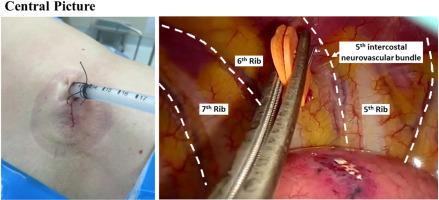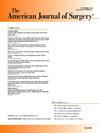Intercostal nerve block is superior than erector spinae plane block after uniportal video-assisted thoracoscopic surgery: randomized controlled trial
IF 2.7
3区 医学
Q1 SURGERY
引用次数: 0
Abstract
In this double-blinded, randomized controlled trial, sixty patients undergoing elective uniportal video-assisted thoracoscopic surgery (VATS) lobectomy were randomly assigned to receive thoracoscopic intercostal nerve block (ICNB, n = 30) or ultrasound-guided erector spinae plane block (ESPB, n = 30).
No block-related adverse events occurred. The ICNB group showed significantly lower resting and coughing visual analog scale scores, than the ESPB group, 4 (4.0 and 5.0 versus 5.0 and 6.0, p = 0.006 and 0.012) and 8 (3.0 and 4.0 versus 5.0 and 6.0, p = 0.003 and 0.017) hours postoperatively. The ESPB group consumed morphine significantly earlier (1.5 versus 10 h, p = 0.002), and had a higher 24-h cumulative consumption (11 versus 7 mg, p = 0.103). No differences were observed in postoperative nausea, vomiting, complications, drainage duration, or hospital stay.
ICNB demonstrated superior early analgesic efficacy, whereas ICNB and ESPB depicted safety and facilitated rapid recovery following uniportal VATS lobectomy.

肋间神经阻滞优于单门电视胸腔镜手术后竖脊面阻滞:随机对照试验
在这项双盲、随机对照试验中,60例接受选择性单门静脉胸腔镜手术(VATS)肺叶切除术的患者被随机分配接受胸腔镜肋间神经阻滞(ICNB, n = 30)或超声引导直立者脊柱平面阻滞(ESPB, n = 30)。未发生阻滞相关不良事件。ICNB组术后4小时(4.0和5.0比5.0和6.0,p = 0.006和0.012)和8小时(3.0和4.0比5.0和6.0,p = 0.003和0.017)的静息和咳嗽视觉模拟评分明显低于ESPB组。ESPB组吗啡消耗明显早于对照组(1.5 mg vs .10 mg, p = 0.002),且24小时累计吗啡消耗较高(11 mg vs . 7 mg, p = 0.103)。术后恶心、呕吐、并发症、引流时间或住院时间均无差异。ICNB表现出优越的早期镇痛效果,而ICNB和ESPB表现出安全性,并促进单门静脉ats肺叶切除术后的快速恢复。
本文章由计算机程序翻译,如有差异,请以英文原文为准。
求助全文
约1分钟内获得全文
求助全文
来源期刊
CiteScore
5.00
自引率
6.70%
发文量
570
审稿时长
56 days
期刊介绍:
The American Journal of Surgery® is a peer-reviewed journal designed for the general surgeon who performs abdominal, cancer, vascular, head and neck, breast, colorectal, and other forms of surgery. AJS is the official journal of 7 major surgical societies* and publishes their official papers as well as independently submitted clinical studies, editorials, reviews, brief reports, correspondence and book reviews.

 求助内容:
求助内容: 应助结果提醒方式:
应助结果提醒方式:


